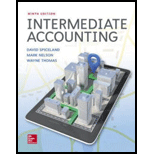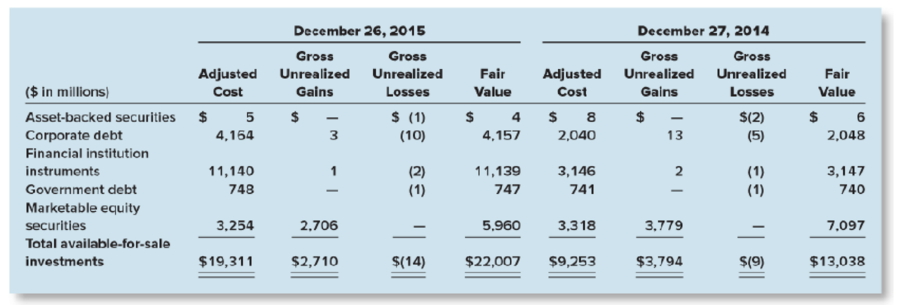
Real World Case 12–1
Intel’s investments
• LO12-4
The following disclosure note appeared in the December 26, 2015, annual report of the Intel Corporation.
Note 5: Cash and Investments (partial)
Available-for-sale investments as of December 26, 2015, and December 27, 2014, were as follows:

Intel also indicates the following: “During 2015, we sold available-for-sale investments for proceeds of $2.2 billion . . . The gross realized gains on sales of available-for-sale investments were $133 million in 2015. Intel’s Note 24 (Other Comprehensive Income) indicates unrealized holding losses of $999 million during 2015, and a reclassification adjustment of $93 for gains that had previously been included in OCI and recorded in the fair value adjustment but which were now being included in net income after being realized upon sale. Note: Intel’s 2015 financial statements were issued prior to the effective date of ASU 2016-01, so Intel includes equity investments among its available-for-sale investments. That difference from current GAAP will not affect your answer to the case questions.
Required:
1. Draw a T-account that shows the change between the December 27, 2014, and December 26, 2015, balances for the fair value adjustment associated with Intel’s AFS investments for 2015. By how much did the fair value adjustment change during 2015?
2. Prepare a
3. Prepare a journal entry that records any reclassification adjustment for available-for-sale investments sold during 2015. Ignore income taxes.
4. Using your journal entries from requirements 2 and 3, adjust your T-account from requirement 1. Have you accounted for the entire change in the fair value adjustment that occurred during 2015? Speculate as to the cause of any difference.
Want to see the full answer?
Check out a sample textbook solution
Chapter 12 Solutions
Intermediate Accounting
- Calculate the times-interest-earned ratios for PEPSI CO, Given the following informationarrow_forwardCalculate the times-interest-earned ratios for Coca Cola in 2020. Explain if the times-interest-earned ratios is adequate? Is the times-interest-earned ratio greater than or less than 2.5? What does that mean for the companies' income? Can the company afford the interest expense on a new loan?arrow_forwardWhich of the following is a temporary account?A. EquipmentB. Accounts PayableC. Utilities ExpenseD. Common Stockarrow_forward
- Unearned revenue becomes revenue when:A. A sale is madeB. Cash is receivedC. The service is performedD. The revenue is recordedarrow_forwardWhat is the effect of a debit to an expense account?A. Decreases expensesB. Increases equityC. Increases expensesD. Decreases assetsarrow_forwardIf total debits exceed total credits on a trial balance, the difference is most likely:A. A net lossB. A recording errorC. A net incomeD. An overstatement of assetsarrow_forward
- Which of the following accounts would be found on the post-closing trial balance?A. Service RevenueB. Salaries ExpenseC. Retained EarningsD. Dividendsarrow_forwardNeed answer What type of account is Service Revenue?A. AssetB. LiabilityC. EquityD. Revenuearrow_forwardNo chatgpt What type of account is Service Revenue?A. AssetB. LiabilityC. EquityD. Revenuearrow_forward
 Financial Reporting, Financial Statement Analysis...FinanceISBN:9781285190907Author:James M. Wahlen, Stephen P. Baginski, Mark BradshawPublisher:Cengage Learning
Financial Reporting, Financial Statement Analysis...FinanceISBN:9781285190907Author:James M. Wahlen, Stephen P. Baginski, Mark BradshawPublisher:Cengage Learning Intermediate Accounting: Reporting And AnalysisAccountingISBN:9781337788281Author:James M. Wahlen, Jefferson P. Jones, Donald PagachPublisher:Cengage Learning
Intermediate Accounting: Reporting And AnalysisAccountingISBN:9781337788281Author:James M. Wahlen, Jefferson P. Jones, Donald PagachPublisher:Cengage Learning Financial & Managerial AccountingAccountingISBN:9781285866307Author:Carl Warren, James M. Reeve, Jonathan DuchacPublisher:Cengage Learning
Financial & Managerial AccountingAccountingISBN:9781285866307Author:Carl Warren, James M. Reeve, Jonathan DuchacPublisher:Cengage Learning Accounting (Text Only)AccountingISBN:9781285743615Author:Carl Warren, James M. Reeve, Jonathan DuchacPublisher:Cengage Learning
Accounting (Text Only)AccountingISBN:9781285743615Author:Carl Warren, James M. Reeve, Jonathan DuchacPublisher:Cengage Learning




